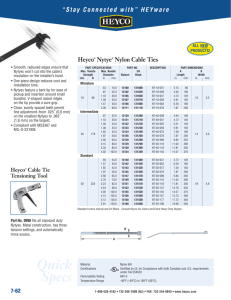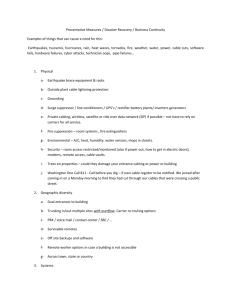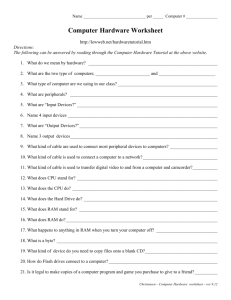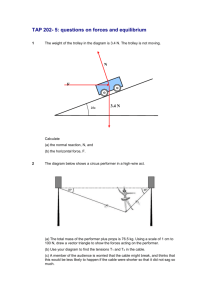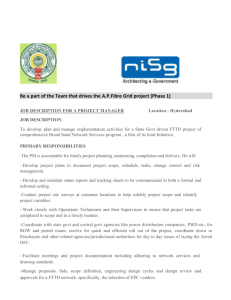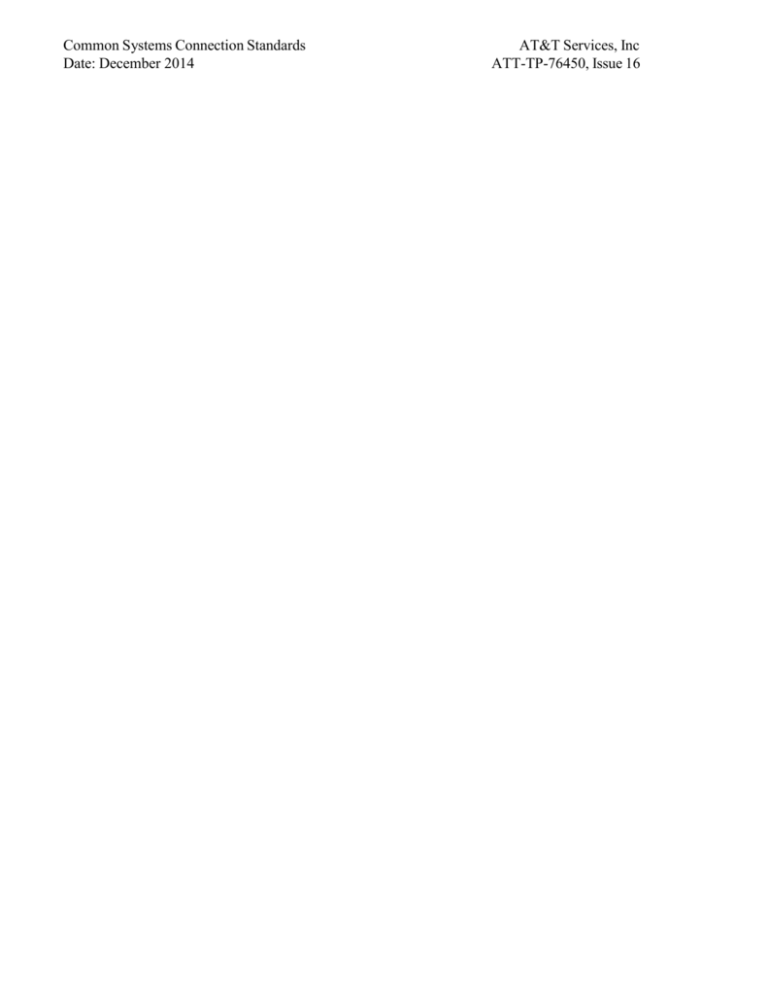
Common Systems Connection Standards
Date: December 2014
AT&T Services, Inc
ATT-TP-76450, Issue 16
Common Systems Connection Standards
Date: December 2014
AT&T Services, Inc
ATT-TP-76450, Issue 16
7 APPENDIX A – ATT-TP-76450 Checklist Instructions and Process
7.1
Purpose
The purpose of this appendix is to assist product suppliers with preparing and furnishing
equipment documentation to the company representative for product evaluation purposes.
7.2
Scope
An evaluation reviews a product against all applicable requirements based on the equipment
and its intended use in the network. Unless otherwise stated, all requirements apply to
equipment systems and equipment units that will be installed in network equipment buildings
and equipment areas within buildings, electronic equipment enclosures such as controlled
environment vaults, outside mounted electronic equipment cabinets, and at customer locations.
7.3
Instructions:
Manufacturer is to complete the ATT-TP-76450 Checklist in Appendix B as follows:
Mark the appropriate column in the checklist as follows:
“Yes” indicates that the equipment listed is compliant to the requirement.
“No” indicates that the equipment listed is not compliant to the requirement.
“N/A” indicates that the requirement is not applicable to the equipment listed. Each
requirements checked “N/A” must include an explanatory footnote.
.If product is ATT-TP-76200 Level 3 or unknown respond to each requirement in the
checklist.
If product is ATT-TP-76200 Level 1 or OSP respond only if applicable column is marked
“yes”.
*If equipment is evaluated by manufacturer as compliant, but deviates in some way from the
stated requirement, mark “Part” (partial) in the “No” column and include an explanatory
footnote.
Explanatory footnotes should be placed in the matrix following the checklist and reference
specific requirement numbers for each comment.
Forward supporting documentation as required in Section 7.3.
Note: Any No or N/A responses require written detailed in comments and supporting
documentation.
AT&T Services, Inc
ATT-TP-76450, Issue 16
Common Systems Connection Standards
Date: December 2014
7.4
Process:
Requirements marked “Yes” for compliance will require no further action.
Requirements marked “No” for non-compliance will trigger the AT&T SME for the requirement
to contact the manufacturer in an effort to resolve the non-compliance. All issues must be
resolved before the equipment is approved for use in AT&T.
Footnote references for requirements marked “N/A” for not applicable or “Part” for partially
compliant will be reviewed by the AT&T SME for that requirement. The SME may initiate
contact with the vendor for further clarification and/or resolution.
When compliance/resolution to all requirements is met, the ATT-TP 76450 SPOC will notify the
AT&T Product Manager for the equipment that it is compliant.
Forward the completed checklist and supporting documentation as required in Section 7.3 to:
John Tablerion
15248 S. Ravinia
Orland Park Ill. 60462
Office: 708-403-4450
Fax: 708-460-4457
Email: jt3216@att.com
Copyright ©2014, AT&T . All Rights Reserved.
Page 30
AT&T Services, Inc
ATT-TP-76450, Issue 16
Common Systems Connection Standards
Date: December 2014
Appendix B – ATT-TP 76450 Checklist
(NOTE: No or N/A responses below require written detailed in comments)
Manufacturer:
Date:
Equipment Name/Model Number, etc.:
Contact Name:
Phone Number:
Product Description (check all that apply):
Frame or Cabinet
Multi-Frame or Cabinet
Single Shelf
Multi-Shelf
Transport Product
Switching Product
Customer Premises Application
Non-network Product
ATT-TP-76200 Evaluation Type:
Level 1
Level 3
OSP
Note: If product is Level 3 or unknown respond to each requirement number below. If product
is only Level 1 or OSP only respond if applicable column below is marked “yes”.
*Refer to paragraph number in previous sections for detailed requirements
OSP
L1
Rqmt* Description
2 DC POWER INTERCONNECTION STANDARDS
2.1 General
2.1.1
Nominal -48V DC Power
yes yes
2.1.2
AC Powered Equipment
yes yes
2.2.1
Redundant Power Feeds
n/a n/a
2.2.2.
Power Feeder Information
n/a n/a
2.2.3
Battery Return Conductor
n/a n/a
2.2.4
Battery Return Configuration DC-I
n/a n/a
2.2.5
Diverse Cable Routing
n/a n/a
2.3.1.
Rear Power Terminations
n/a n/a
2.3.2
Front Power Terminations.
n/a n/a
2.4.1
8 AWG and Larger Stranded Power Cable
n/a n/a
2.4.2
16 AWG to 10 AWG Stranded Power Cable
n/a n/a
2.4.3
Equipment surface terminations
n/a n/a
2.4.4
18 AWG Power Cable and Smaller
n/a n/a
2.4.5
Compliance to Table 2-1
yes n/a
2.5
AC Connectors
yes n/a
n/a n/a
2.6.1
yes
Circuit Breakers / No Power Protection – Requires bay
mounted fuse panel
2.6.2
Fuses
yes n/a
2.6.3
yes n/a
2.6.4
Power Protection Quality
n/a n/a
n/a n/a
Copyright ©2014, AT&T . All Rights Reserved.
Page 31
Yes
No
N/A
Common Systems Connection Standards
Date: December 2014
AT&T Services, Inc
ATT-TP-76450, Issue 16
2.7
Filtered Battery
2.8
Special PDU
2.9
Integrated Power Distribution
2.10
Visual Alarms and Status Indicator
3 SYNCHRONIZATION/EXTERNAL TIMING INTERFACE
STANDARDS
Please read the text of section 3 completely before proceeding
with this section of the questionnaire. If you have any questions
about the requirements of this section and its applicability to your
DUC, or have suggestions for improving the format of this
section, please contact the AT&T Common Systems
synchronization SME. Text of explanations to questions posed in
the questionnaire should be posted in the Notes section.
3.1.1 Will the DUC, as it will be deployed in the AT&T
network, require an external frequency timing reference
sourced from the site BITS systems? Enter Yes or No.
If response is No, explain why the DUC does not require
an external frequency timing reference sourced from the
site BITS systems (e.g.: asynchronous only applications
as metro
Ethernet,timing
asynchronous
IP transport,
3.1.2 such
Describe
the external
signal format(s)
supported
DUC
be line
timed,
yes, proceed to
(e.g.:will
DS1,
CC, or
E1,loop
2048
kHz)etc).
in theIf notes.
3.1.2. If no, skip to 3.2.1.
3.1.3
3.1.4
3.2.1
n/a
n/a
n/a
yes
n/a
n/a
n/a
yes
yes
n/a
yes
n/a
yes
If 3.1.2 is No, mark 3.1.3 N/A. If 3.1.2 is Yes, does the
DUC accept GR-1244-CORE compliant DS1 or CC
frequency timing input references? Respond Yes or
No. If 3.1.3 is Yes, explain the number and type of
input references in the notes. If 3.1.2 is NO, explain the
signal format of the external frequency references that
are supported by the DUC.
Describe the external timing input interface in the notes. yes
Include a description of the type of connections, the
location of the connections, and the termination
impedances supported for each signal format. If the
external timing input interface is not compliant to AT&T
standards as described in section 3.0, please explain
how the non-compliant interface will be mitigated.
yes
Will the DUC, as deployed in AT&T, require a separate
dedicated GPS antenna and receiver system to supply
precision frequency, time, phase, or location
synchronization? Enter Yes or No. If the response is Yes,
please explain the synchronization requirements or direct
the AT&T Common Systems sync SME to
supplier documentation submitted in support of this
Copyright ©2014, AT&T . All Rights Reserved.
review.
Page 32
n/a
n/a
n/a
AT&T Services, Inc
ATT-TP-76450, Issue 16
Common Systems Connection Standards
Date: December 2014
3.3.1
3.3.2
3.3.3
3.3.4
3.4.1
Yes, please explain the synchronization requirements or
direct the AT&T Common Systems sync SME to
supplier documentation submitted in support of this
review.
Questions 3.3.1 through 3.3.4 apply to a DUC that utilizes
a PTP client for the timing solution. Note that the use of
PTP may vary depending on the location of
the DUC in a CO, MTSO, vs. a remote terminal or base
station. Does the DUC, as deployed in AT&T, require PTP
for a timing solution? Respond Yes or No. If response is
yes, please proceed to 3.3.2. If response is NO, please
skip to section 3.4.
Is the PTP client in the DUC compliant to the current
version of the ITU-T PTP Telecom Profile? Respond Yes
or No.
Please describe in the notes the level of precision
required at the PTP timed DUC in parts per million for
frequency, and/or time/phase accuracy for time of day or
phase
requirements.
Is the PTP
client in the DUC compatible with IPv6?
yes
n/a
yes
n/a
yes
n/a
yes
Questions 3.4.1 through 3.4.3 apply to a DUC that utilizes yes
a NTP client for the timing solution. Does the DUC require
NTP to deliver a frequency, time, and/or phase reference
to the DUC or downstream connected network elements?
Respond Yes or No.
n/a
n/a
yes
n/a
yes
n/a
n/a
yes
n/a
n/a
n/a
n/a
n/a
n/a
n/a
n/a
n/a
n/a
yes
yes
yes
yes
n/a
n/a
n/a
yes
yes
yes
3.4.2
What is the frequency, time, and/or phase accuracy
required? Please respond in the notes.
3.4.3 Is the NTP source for this DUC and associated platform
specific to the platform, meaning a dedicated GPS
antenna and receiver are required as the NTP source?
Respond Yes or No. If the response is Yes, please
explain the NTP source requirements or direct the AT&T
Common Systems sync SME to supplier documentation
submitted in support of this review.
4 ALARMS
4.1
Equipment surveillance is performed at two levels,
remote surveillance and local surveillance
4.2
Local and Telemetry Alarms
4.3
Separation of Local Alarms
4.4
Audible Alarm Cut-off (ACO)
4.5
Telemetry Alarm Protocols (Meets one of the listed protocols)
4.6
Alarm Interconnection
4.7
Discrete Alarm Rating
4.8
Normally open and normally closed alarm outputs (Form
“C” alarm relats are preferred
4.9
Discrete Alarm Paired Leads
4.10
Discrete Alarm Dry Contacts
4.11
Housekeeping/Overhead Alarm Inputs
Copyright ©2014, AT&T . All Rights Reserved.
Page 33
AT&T Services, Inc
ATT-TP-76450, Issue 16
Common Systems Connection Standards
Date: December 2014
5 FIBER
5.1
Fiber Optic Cable
5.2
Fiber Connector Boots
5.3
Overall Fiber Connector and Boot Length
5.4
Fiber Bend Radius
5.5
Minimum Distance Between Connector Housing
and 90 Degree Bend
5.6
Space Between Door/Panel and Fiber Connector
5.7
Standard Fiber Connector
6 COPPER CABLE
DS3/STS-1 Connector & Cabling BNC Connector
6.1
Alternative DSC/STS-1 Connector
6.2
6.3
Coaxial Stripping Tools and Crimping Tools
6.4
DS1 Cross-Connect Wire
6.5
DSL Cross-Connect Wire
6.6
Electrical Ethernet Cabling
6.7
Electrical Jumper (Cross-Connect) – Standards
6.8
Data Patch Panels 6.9
Media Converter
Central Office Copper Wire and Cable Flammability Ratings
6.10
Central Office Copper Wire and Cable
6.11
6.12
6.13
6.14
6.15
Central Office Copper Coaxial Cable
Central Office Copper "Bits" Synchronous Timing Cables
Central Office Copper Wire and Cable Minimum Inside Bend
Radius
Central Office Copper Coaxial Cable Minimum Inside Bend
Radius
Copper Cable Terminations
6.16
6.17
Cable Trays
6.18
Tie Bar
Use of "Y" Cable
6.19
6.20
Unusual Cable Types
6.21
Protection of Cable and Jumpers
7 VENDOR DOCUMENTATION
7.1
Softcopy Documentation
7.2
Craft Interface Instructions
7.3
Installation Guide: installation, provisioning, and testing
Copyright ©2014, AT&T . All Rights Reserved.
Page 34
n/a
n/a
n/a
n/a
n/a
n/a
n/a
n/a
n/a
n/a
n/a
n/a
n/a
n/a
n/a
n/a
n/a
Yes
Yes
Yes
Yes
n/a
n/a
Yes
Yes
n/a
n/a
n/a
n/a
n/a
n/a
n/a
n/a
n/a
n/a
n/a
yes
yes
yes
n/a
n/a
n/a
yes
n/a
n/a
n/a
n/a
n/a
n/a
n/a
n/a
n/a
n/a
n/a
n/a
n/a
Yes n/a
Yes n/a
Yes n/a
AT&T Services, Inc
ATT-TP-76450, Issue 16
Common Systems Connection Standards
Date: December 2014
of the network element
7.4
Installation Guide: Creation, provisioning, and testing of a
multi-node ring or system
7.5
7.6
7.7
7.8
7.9
Alarm/Trouble Shooting Guide
Personnel Injury and Equipment Damage Warnings
Reference Guide
Consistent terminology throughout Documentation
Consistent terminology between Documentation &
Platform
7.10
Revisions Numbering
7.11
Revision History
8 OTHER INTERCONNECTION REQUIREMENTS
8.1
Equipment Lighting
8.2
Test (Streaker) Card Standards
8.3
Determining Bar Code Requirement
8.3.2
Applying Bar Codes to Plug-In Units and Shelves
8.3.3
Applying Bar Codes to Cabinets
“NO”,“Part” & “N/A” Footnotes: (Required)
Rqmt#
Comment
Copyright ©2014, AT&T . All Rights Reserved.
Page 35
n/a
n/a
Yes
Yes
Yes
Yes
Yes
n/a
n/a
n/a
n/a
n/a
Yes n/a
Yes n/a
n/a
n/a
n/a
n/a
n/a
n/a
n/a
n/a
n/a
yes
AT&T Services, Inc
ATT-TP-76450, Issue 16
Common Systems Connection Standards
Date: December 2014
8 APPENDIX C - References
ATT TP documents may be obtained on the AT&T Technical Publication and Nebs Web site.
Telcordia documents may be obtained directly from Telcordia Technologies Inc.
Document Number
ATT-TP-76200
ATT-TP-76300
ATT-TP-76305
ATT-TP-76305-001
ATT-TP-76305-002
ATT-TP-76306
ATT-TP-76400
ATT-TP-76401
ATT-TP-76401-001
ATT-TP-76406
ATT-TP-76407
ATT-TP-76408
ATT-TP-76410
ATT-TP-76412
ATT-TP-76413
ATT-TP-76414
ATT-TP-76415
ATT-TP-76416
ATT-TP-76419
ATT-TP-76430
ATT-TP-76450
ATT-TP-76460
ATT-TP-76461
GR-137-CORE
GR-518-CORE
GR-253-CORE
GR-436-CORE
GR-454-CORE
GR-1209-CORE
GR-449-CORE
FR-439
TR-EOP-000001
GR-833-CORE
TR-NWT-000930
GR-2419-CORE
Document Description
Network Equipment – Building Systems
Installation Guide within the Central Office
Cable Installation & Removal
SNFA Cable Installation & Removal
48V DC Power Single Line Diagrams
Firestopping (non-workmanship & processes)
Detail Engineer Requirements for the C.O.
Space Planning
Floor Loading Considerations
Distributing Frames
Equipment Framework
Equipment Superstructure
Raised Floors
Telco Electrical and Optical Ethernet Standards
Connecting Block Standards (89-MDF type)
Connecting Block Standards (COSMIC 78-112
type)
Connecting Block Standards for Protectors
Bonding & Grounding
High-Twist Distributing Frame Wire Standards
Synchronization Standards
Common Systems Standards
Fiber optic Protection in the Central Office
Fiber optic Connector Cleaning
Telcordia-Generic Requirements for Central Office
Cable
Telcordia – Generic Switch Synchronization
Telcordia – SONET Synchronization for the
Network
Telcordia – Digital Synchronization Plan
Telcordia –Supplier-Provided Documentation
Telcordia –Fiber optic Branching Components
Telcordia –Fiber Distributing Frames
Telcordia – Operations Technology Generic
Requirements (OTGR)
Telcordia – Lightning, Radio Frequency, and 60Hz Disturbances at the BOC Network Interface
Telcordia – NE and Transport Surveillance
Messages
Telcordia – Hybrid Microcircuits Used in
Telecommunications Equipment
Telcordia – Human Factors Requirements for
Equipment to Improve Network Integrity
Copyright ©2014, AT&T . All Rights Reserved.
Page 36
Current
Current
Current
Current
Current
Current
Current
Current
Current
Pending
Current
Current
Current
Current
Current
Pending
Pending
Current
Current
Current
Current
Pending
Current
Current
Current
Current
Current
Current
Current
Current
Current
Current
Current
Current
Current
AT&T Services, Inc
ATT-TP-76450, Issue 16
Common Systems Connection Standards
Date: December 2014
9 Appendix D - ATT Contact List
Hector Garcia, Principal-Network Design-Engineer -Common Systems Standards, DSX, Copper
Cable Standards
(626)449-8888, E-Mail: we2583@att.com
Doug Florence, Principal-Network Design-Engineer ER - Common Systems Standards, New
Product Integration
(925) 867-9951, E-Mail: df1538@att.com
Ed Granger, Principal-Network Design-Engineer - Common Systems
DC Power Section 2.
(843)727-6754, E-Mail: eg1724@att.com
Wayne Hillesheim, Principal-Network Design-Engineer - Common Systems Standards
Alarm Standards
(706)633-9154, E-Mail: wh2956@.att.com
Dave Overdorf, Principal-Product Development Engineer - Common Systems Standards,
Synchronization Standards
(770)232-9183, E-Mail: do3863@att.com
John Tablerion, Principal-Network Design-Engineer- Common Systems Standards, ATT-TP76200)
(708) 403-4450, E-Mail: jt3216@att.com
Mike Yeilding, Principal Product Development Engineer
Infrastructure Planning and Optimization – Common Systems
Fiber Section 5.
(858)621-4651 , E-Mail: my1515@att.com
Keith Lanning- Principal-Network Design-Engineer Common Systems Standards,
Labeling Section ( 8.3) Lighting Section (8.3) (770)329-7193 E-Mail: kl1825@att.com
10 Appendix E – Acronyms
a) The term product supplier as used throughout this section refers to the equipment
manufacturer or agent of the equipment manufacturer, whichever is appropriate for the
product being considered.
b) Requirements are those product features that must be provided by the equipment
manufacturer. The words “shall” and “must” are used throughout this section to identify
requirements.
c) Objectives are product features that are desired for the long term use or application.
The word “should” is used throughout this section to identify objectives.
Copyright ©2014, AT&T . All Rights Reserved.
Page 37
AT&T Services, Inc
ATT-TP-76450, Issue 16
Common Systems Connection Standards
Date: December 2014
d) NE- Network Equipment or Network Element package provided by the Manufacturer for
consideration.
e) OEM – Original Equipment Manufacturer
f) OSMINE – Operations Systems Modifications for Integration of Network Elements
g) PDM – Product Manager
h) PDU – Power Distribution Unit
i) RMU – Rack Mounting Unit
j) TIRKS – Trunk Integrated Records Keeping System
SME- Subject Matter Expert
Copyright ©2014, AT&T . All Rights Reserved.
Page 38

